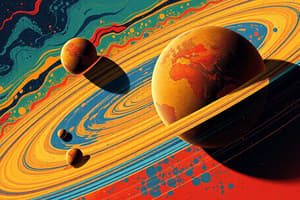Podcast
Questions and Answers
What event initiated the formation of the solar system according to the protoplanet hypothesis?
What event initiated the formation of the solar system according to the protoplanet hypothesis?
- Collision of large celestial bodies
- Formation of stable gas giant planets
- Contraction of a massive cloud of dust and gas (correct)
- The explosion of a nearby supernova
Which materials primarily contributed to the formation of proto-planets?
Which materials primarily contributed to the formation of proto-planets?
- Carbon dioxide and hydrogen sulfide
- Liquid metals and noble gases
- Oxygen and nitrogen compounds
- Frozen water, ammonia, methane, and iron (correct)
What characteristic differentiates terrestrial planets from Jovian planets in the solar system?
What characteristic differentiates terrestrial planets from Jovian planets in the solar system?
- Terrestrial planets are located far from the Sun
- Terrestrial planets have rocky surfaces (correct)
- Terrestrial planets are gas giants
- Terrestrial planets have extensive ring systems
How did moons form around the proto-planets?
How did moons form around the proto-planets?
What phenomenon is believed to have contributed to the formation of Earth's moon?
What phenomenon is believed to have contributed to the formation of Earth's moon?
What effect did the Sun's heat have on the protoplanets closest to it?
What effect did the Sun's heat have on the protoplanets closest to it?
Flashcards are hidden until you start studying
Study Notes
Protoplanet Hypothesis Overview
- Solar system originated approximately 5 billion years ago from a vast cloud of dust and gas, called a nebula.
- The nebula primarily consisted of hydrogen and helium, situated in the Orion arm of the Milky Way galaxy.
- Gravitational forces caused the cloud to contract, leading to the formation of a proto-Sun at the center.
Planet Formation Process
- Dust particles condensed under gravity, forming proto-planets which accreted materials such as frozen water, ammonia, methane, and various metals.
- The remaining materials surrounded the proto-Sun and formed a rotating disc, from which the planets emerged.
- Momentum transferred outward during this process contributed to the formation of the solar system's architecture.
Characteristics of Terrestrial and Jovian Planets
- Terrestrial planets, closest to the Sun, lost their outer gases due to intense solar heat, resulting in rocky surfaces.
- Jovian planets, located farther from the Sun, retained their gaseous envelopes and possess gas-dominated surfaces.
Moon Formation
- Moons formed when smaller dust particles, captured by a planet's gravitational pull, began to orbit these planets.
- The Earth’s moon is hypothesized to have formed from a massive collision with a large object, supported by similarities in composition to Earth's mantle.
Studying That Suits You
Use AI to generate personalized quizzes and flashcards to suit your learning preferences.




